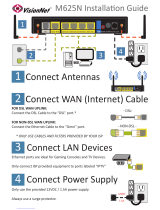
7
AC1600 WiFi VDSL/ADSL Modem Router Model D6400
Manage the Configuration File of the Modem Router. . . . . . . . . . . . . . . . . . . . 222
Back Up the Settings . . . . . . . . . . . . . . . . . . . . . . . . . . . . . . . . . . . . . . . . . . . . . 222
Restore the Settings . . . . . . . . . . . . . . . . . . . . . . . . . . . . . . . . . . . . . . . . . . . . . . 222
Recover the admin Password. . . . . . . . . . . . . . . . . . . . . . . . . . . . . . . . . . . . . . . . . 223
Return the Modem Router to Its Factory Default Settings. . . . . . . . . . . . . . . . 224
Use the Reset Button . . . . . . . . . . . . . . . . . . . . . . . . . . . . . . . . . . . . . . . . . . . . . 224
Erase the Settings . . . . . . . . . . . . . . . . . . . . . . . . . . . . . . . . . . . . . . . . . . . . . . . . 225
View the Status and Statistics of the Modem Router . . . . . . . . . . . . . . . . . . . . 226
View Information About the Modem Router and the Internet,
Modem, and WiFi Settings. . . . . . . . . . . . . . . . . . . . . . . . . . . . . . . . . . . . . . . . . 226
View the Traffic Statistics . . . . . . . . . . . . . . . . . . . . . . . . . . . . . . . . . . . . . . . . . 230
View, Renew, or Release a TCP/IP Internet Connection . . . . . . . . . . . . . . . . 232
View, Connect, or Disconnect a PPPoE or PPPoA Internet Connection . . . 234
Manage the Activity Log . . . . . . . . . . . . . . . . . . . . . . . . . . . . . . . . . . . . . . . . . . . . 235
View and Manage the Log . . . . . . . . . . . . . . . . . . . . . . . . . . . . . . . . . . . . . . . . . 235
Specify Which Activities Are Logged. . . . . . . . . . . . . . . . . . . . . . . . . . . . . . . . 237
View Devices Currently on the Network . . . . . . . . . . . . . . . . . . . . . . . . . . . . . . . 237
Monitor and Meter Internet Traffic . . . . . . . . . . . . . . . . . . . . . . . . . . . . . . . . . . . 238
Start the Traffic Meter Without Traffic Volume Restrictions . . . . . . . . . . . . 238
View the Traffic Statistics and Traffic Status . . . . . . . . . . . . . . . . . . . . . . . . . 239
Restrict Internet Traffic by Volume . . . . . . . . . . . . . . . . . . . . . . . . . . . . . . . . . 240
Restrict Internet Traffic by Connection Time . . . . . . . . . . . . . . . . . . . . . . . . . 242
Unblock the Traffic Meter After the Traffic Limit Is Reached . . . . . . . . . . . 244
Manage the Modem Router Remotely . . . . . . . . . . . . . . . . . . . . . . . . . . . . . . . . . 244
Remotely Access the Modem Router Using the genie App . . . . . . . . . . . . . . . . 246
Configure the Modem Router as a DSL Modem Only . . . . . . . . . . . . . . . . . . . . 246
Chapter 13 Use VPN to Access Your Network
Set Up a VPN Connection. . . . . . . . . . . . . . . . . . . . . . . . . . . . . . . . . . . . . . . . . . . . 249
Specify VPN Service in the Modem Router . . . . . . . . . . . . . . . . . . . . . . . . . . 249
Install OpenVPN Software on Your Computer . . . . . . . . . . . . . . . . . . . . . . . . 250
Use a VPN Tunnel . . . . . . . . . . . . . . . . . . . . . . . . . . . . . . . . . . . . . . . . . . . . . . . . 252
Use VPN to Access the Modem Router’s USB Device and Media . . . . . . . . . . . 253
Use VPN to Access Your Internet Service at Home . . . . . . . . . . . . . . . . . . . . . . 254
Set Up VPN Client Internet Access in the Modem Router. . . . . . . . . . . . . . . 254
Block VPN Client Internet Access in the Modem Router. . . . . . . . . . . . . . . . 255
Use a VPN Tunnel to Access Your Internet Service at Home . . . . . . . . . . . . 256
Chapter 14 Manage Port Forwarding and Port Triggering
Manage Port Forwarding to a Local Server for Services and Applications. . . 258
Forward Incoming Traffic for a Default Service or Application . . . . . . . . . . 258
Add a Port Forwarding Rule with a Custom Service or Application. . . . . . . 259
Change a Port Forwarding Rule . . . . . . . . . . . . . . . . . . . . . . . . . . . . . . . . . . . . 261
Remove a Port Forwarding Rule . . . . . . . . . . . . . . . . . . . . . . . . . . . . . . . . . . . . 262
Application Example: Make a Local Web Server Public . . . . . . . . . . . . . . . . . 263
How the Modem Router Implements the Port Forwarding Rule . . . . . . . . . 264
Manage Port Triggering for Services and Applications . . . . . . . . . . . . . . . . . . . 264






















